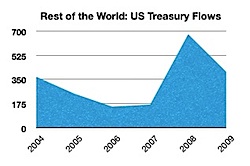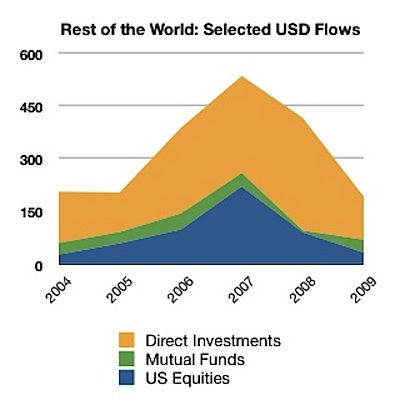We won’t have to consult the Consumer Price Index to know when the much feared Obama-inflation monster has finally arrived to devour what savings we have left. All that will be necessary will be to look at the average yield on short-term money-market funds.
In the 21st Century, money market funds are now the center of the short-term banking system — and are largely unregulated by the US monetary authorities.
In Q1 2009, total assets of money market mutual funds, according to Fed flow of funds table L.206, were $3.7 trillion, 5.6 times the $666.6 billion in checkable demand deposits with commercial banks. Demand deposits are now only 5.1% of commercial bank liabilities.
The MMF: the non-bank bank
Although money market funds are classified as securities and regulated by the SEC, rather than by the banking authorities, they are, in fact, a banking operation. They take money from “depositors”, with the understanding that it may be withdrawn at any time, on demand, by checks that are cleared along with drafts on commercial banks.
The “depositors” in money market funds do so with the understanding that they will be able to withdraw the amount deposited, plus a variable rate of interest, whenever they feel like it.
Of course, technically, “deposits” in a money market fund are not a liability of the fund, but rather equity in the form of shares, usually with a net asset value adjusted daily to a one dollar benchmark by issuing additional fractional shares in the amount of the interest earned in one day.
Like commercial banks, money market funds invest “depositors’” money in short-term loans, usually commercial paper.
However, unlike commercial banks, money market funds do not have to maintain reserves with the central bank, nor do they normally set up reserves for doubtful receivables. Furthermore, unlike commercial banks, their “deposits” are not guaranteed by the government (until the Crash of 2008).
For practical purposes, a money market fund is the same as a bank. A fund borrows short and lends long and promises to pay depositors on demand, principal plus interest.
An unfair advantage
Because money market funds do not maintain reserves with the central bank, they are able to pay substantially higher interest than available on demand deposits at commercial banks. Nor do money market funds normally offer drive-in tellers, night depositories, or the myriad other services that regular banks offer depositors.
In 1968, when the first money market fund was set up in Brazil, during the years of the economic miracle, the Minister of Finance quickly realized the dangers of this new instrument and slapped strict restraints on marketing.
However, three years later, when money market funds were introduced in the United States, the authorities did not perceive any potential problems, mainly because the instrument seemed to fall under the jurisdiction of the SEC, rather than the banking authorities.
In order to see systemic risk in a new product or operation, regulators must have multiple jurisdictional understanding, reponsibility, and authority. Because the SEC saw only the risks of investors losing money, they could not perceive the larger threat to the banking system.
The problem was, however, that banks, particularly savings banks, had legal limits imposed as to interest that could be paid on deposits. As the Jimmy Carter stagflation grew during the 1970s, and as asset-backed securities were invented to provide a virtually unlimited supply of short-term debt securities to the new money market fund industry, the position of savings banks became untenable.
Since savings bank assets consisted of long term mortgages with fixed interest rates, they were not able to raise rates on deposits to match the rise in short-term interest spurred by the inflation.
The result was the “great sucking sound” (as Ross Perot might put it) of savings bank deposits being transferred to money market funds.
|
|
|
|
Inflation's vortex. A great sucking sound.
|
|
|
|
|
Because American officials were not as smart as their Brazilian counterparts and were hog-tied in a tangle of conflicting regulatory jurisdictions, the savings banks were ultimately destroyed by unfair competition from money market funds, leading the savings and loan crisis of the 1980s and 1990s.
Short-term interest rates and inflation
When the first money market fund was set up in Brazil in 1968, the internal rate of inflation was about 25%. Six month to one year commercial paper, in retail denominations, yielded rates of from 28% to 32%. Interest on bank deposits were limited by usury laws.
As a result, the first money market fund was able to offer rates on what essentially were demand deposits, of about 24% — double commercial bank rates — and still charge an annual “administration” fee of 4% on fund assets! Because there are no capital requirements to manage a money market fund, the potential return on the equity of a money fund manager is virtually limitless. The only limit is marketing ability.
In these extreme circumstances, it is no wonder that the Brazilian authorities saw the dangers posed by the money market fund instrument and drastically reduced marketing options.
Years later, after the prudent ministers of the Brazilian miracle were gone, and as money funds had become popular in the US, the Brazilians copied the American example and allowed money market funds to flourish.
After the Crash of 2008 and the 2009 budgetary madness of the Obama-Pelosi-Reid team, we now look forward to the possibility of inflation rates in the United States to which most Americans have never been exposed. In this context, the regulatory status of money market funds becomes extremely relevant.
With inflation of 25% a year, or more, and with money market funds not subject to bank reserve requirements, the Federal Reserve will be unable to control the money supply.
The reason is simple:
- At 25% a year inflation, long term bonds become worthless. To cover deficit spending, the Treasury will only be able to sell short term bonds. This will push short-term rates to extreme levels.
- As the Treasury issues checks to pay for the Obama “spending is stimulus” plan, the money will leave commercial banks to be deposited in money market funds, which will have no reserve requirements and therefore will be able to pay much higher rates of interest than commercial banks.
- As interest rates rise on short-term paper soar, money market funds will be able to charge higher and higher “administration” fees. With the demise of Glass-Steagall, banks will place depositors money directly in money market funds they control.
- Without the control of reserve requirements on money market funds, the “multiplier effect” of these virtual banks will kick in, as the public moves money from one fund to another, and inflation will get really serious.
What this means is that unless the government cracks down on money market funds, placing them under virtually the same regulatory regime as commercial banks, including the ability to set reserve requirements that can be adjusted upwards as needed, the United States will be at risk of much higher inflation than many can imagine today.
So, what we must watch is the regulatory moves made on money market funds. So far, from the anti-inflationary point of view, noises made by the administration are not encouraging.





 Click these icons to email articles to friends.
Click these icons to email articles to friends.